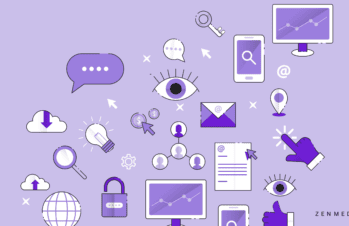David vs. Goliath: a story often used to compare the big-name brands to their smaller counterparts, and it applies to your B2B. But how do the big names become the “Goliaths” of the world? How do they become the first choice for their customers?
It’s often not as hard to get a seat at this table as most presume. It comes down to word of mouth and customer experience.
In the modern world, companies with better brand recognition aren’t necessarily the best. Time and again, we see an audience loving a brand not because it’s the most qualified but because they recognize it.
Whomever your prospects see over and over, that’s who they’re going to trust. You build familiarity through exposure. When you create great content and have earned media, your name is in front of your prospects, affecting your bottom line.
It’s essential to be in front of your market constantly. The more present and in their face you are, the better your chance of winning that business.
Are you in the evaluation arena? Are you the most trusted? Unfortunately, that doesn’t always matter. It’s often about how they think you are rather than your company’s actual experience and accolades. This is the difference between perception and experience—and if you don’t master it, it could cost your B2B sales and a consistent customer base.
So how do you improve your audience’s perception of your business and get the recognition you deserve?
Customer Perception: Why it Matters
A customer’s perception is their opinion of your business or products. It summarizes how customers feel about your brand—including every direct or indirect experience.
When you monitor your customers’ perceptions, your business can spot common pain points and improve the buyer journey for your customers.
72% of customers will not do business with companies after one negative experience. In other words, you’re not far off from the perception of both your brand and quality of service taking precedence over the traditional competitive advantages, like usability, pricing, or features.
You’re at risk of falling behind if you’re not currently investing in your customer experience and perception. According to McKinsey, many businesses are already taking stock of their support and service efforts, with 50% of customer-care leaders rating “investing in new technologies” as one of their top priorities over the next five years.
Customer perception matters. Now, let’s dive into how you can improve and uphold it in your business.
Strike an emotional chord.
The most effective way to maximize customer value is to move beyond just customer satisfaction. You have to connect with customers at an emotional level and tap into their fundamental motivations. Fulfill their deep, often unspoken emotional needs, and your B2B will win in the long run.
After all, actions and words carry a lot of weight. When you actively demonstrate a long-term interest and commitment to your customer relationships through every touchpoint, you build strong bonds and promote a positive experience. But to do this, you have to dig beyond just the surface level and actively listen to your customers’ needs and goals—and you have to do this while also attending to what they’re not saying.
The B2B customer journey has grown more messy, complex, and difficult to track. A major reason for this is that a growing number of purchasing decisions are being made and discussed on dark social—private LinkedIn messages, Slack channels, and closed online communities. Touchpoints are happening all the time in these closed channels, but brands have no way of measuring them. Cue: listening with intent.
When you listen with intent, you grant your customers permission to speak freely and openly about their concerns or complaints. The more they reveal, the more opportunity you have to tap into their motivations and intentions—and you can guide them towards the desired outcome empathetically.
Lean on a positive tone.
Positive emotions have the power to open us up. This means feelings allow us to see more and change our perspective and understanding of possibilities. But people are often hesitant to introduce positive emotions in the business world, and they often operate under the idea that it’s inappropriate or should be minimized.
But, science!
According to research from the Advances in Developmental and Educational Psychology journal, suppressing the interpersonal emotions of employees or customers could lead to a decline in customer satisfaction. In short, the study says that “the expectation from these employees to suppress natural emotional, positive and negative alike, is a mistake. The expression of natural positive emotions is well received and likely to contribute to customer satisfaction and loyalty.”
So how do you do it? How do you lead with positivity to better your customer interactions?
Commit—and be consistent.
Take a step back and consider the role of consistency in your customer onboarding process. To create positive customer perceptions, you’ll want interactions and hand-offs—from sales to support to customer success—to be fluid and reflect how you want customers to view your brand.
Establish core operating values—like integrity, customer focus, and respect—that serve as a framework for your B2B’s interactions, and you’ll have a harmonious customer experience. With core values in place, there are no questions about how to act, what to think, or how to approach customer problems. And when operating values are enforced regularly, customers will expect that level of quality time and again.
Related reading: Here’s Where To Focus Your Marketing Efforts According to Experts
We’re not saying to be sticklers here; there should be flexibility around how you adopt and apply your B2B’s values. Doing so will help you avoid your messaging coming off as impersonal or canned during one-on-one customer interactions.
Follow-ups are your friend.
When you follow up with a friend, you’re more likely to get an answer, right? The same goes for your customers. While it may seem trivial, it’s a small investment with a major payout. About 97% of companies did not send follow-up emails to customers to see if they are satisfied—and that’s a lot of lost opportunities. Motivating customers to return to your B2B again and again strengthens your relationship with them and increases customer loyalty.
Related reading: Customer Retention IS a Growth Strategy
You can enhance the customer’s experience and prevent potential churn when you send follow-up messages. After a positive interaction, for example, you can use a follow-up to upsell and cross-sell. Customers will be more likely to upgrade or buy another product after having a good experience.
But on the other side of the coin, if your customer’s experience was negative, you can use follow-ups to collect customer feedback. Ask them why they had a negative experience and assure them that your business is still the best option for achieving their goals. About 32% of people stop doing business with a brand or company they previously loved after one negative experience.
In other words, with the right follow-up, your B2B could save three out of every 10 unhappy customers—and that’s by simply sending an email or making a phone call.
Positive perceptions will shape your B2B’s future.
The bar is rising when it comes to customer expectations. Customers want to eliminate the complexity involved with solving their problems—and they want you to know when it’s appropriate to balance automation and human outreach.
But to get the brand recognition your B2B deserves, you must acknowledge this shift—or your brand perception will surely take a hit.
If you get the wheels moving in the right direction and place emphasis on the importance of that perceived experience with your brand, you’ll instantly recognize the difference—and it’ll make a positive impact on your B2B’s success. To create this positive perception, you must know who you’re selling to. Develop a deep knowledge of your target audience. Identify your audience at the geographical, sub-vertical, industry, organizational, and buying center levels. Then, treat them like an onion, and peel.
Peel back the layers further to understand the most granular definition of your customer—their buyer persona—and you’ll uncover information about their initiatives, challenges, and preferences. You’ll get a first-hand look at how they experience the buyer journey.
While this insight is critical in design, messaging, and B2B content, it also allows for creating campaigns that resonate and compel your audience to take the desired action. Use this persona information to create tools that enable sales to engage buyers effectively at each buying cycle stage. You’ll improve sales productivity—and become a subject matter expert (S.M.E.) on your buyer.
When you become an S.M.E. on your buyers, you can leverage this expertise to engage with cross-functional teams and drive the alignment between product, marketing, and sales. And you’ll have a seat at the table.
Now, whether your proverbial table is small (your peers) or large (with access to executives), one thing is for certain: earning a seat because you’re a buyer expert will bring tremendous rewards for your B2B—and you’ll be actively contributing to your B2B’s go-to-market success.
Looking for a seat at the table with your customers? We’re here to help. Reach out.









